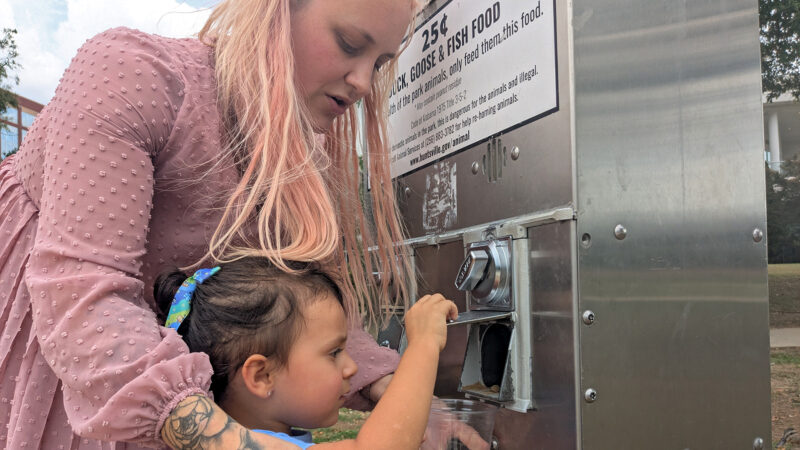Air Quality: Emissions
It starts out like this. A car drives up to the oil change place. One of the guys on the emissions testing crew rushes out to the driver and, delivers the spiel.
“What we’re doing is a free emissions test, and what we’re looking at is some of the gases that comes out of your emissions, both for clean air and also for your fuel consumption. These are the five gases that we look at …”
He gives a thumbs up, and the guy standing behind the car sticks a two-foot-long heat-resistant tube into the exhaust pipe, and thirty seconds later a machine connected to the tube produces a print-out of the results.
“Ma’am here are the printout of the five gases we discussed a while ago….all of yours are good and clean. The monoxide is low, which is a safety in your car. The O2 sensor’s working great, and your hyrdrocarbons and nox on your catalytic converter are doing well so that your’e getting maximum gas efficiently and also so you’re not polluting the air.”
Susan Higgins is on the receiving end of this news. She’s a rehabilitation counselor who is running her 2001 Toyota Camry to the ground. How many miles on it? 223,123!
“The number one constant is high mileage, and the age of the vehicles.”
That’s Danny Patterson, who also goes by Danny Ozone. If your car has high miles and it’s more than 10 years old, chances are good it’s putting out harmful emissions.
“A car that is 25 years old is putting out about as many emissions as 40 new vehicles.”
Patterson is one of the partners in Alabama Partners for Clean Air. Twice a week, he oversees free emissions testing at 41 locations in Jefferson and Shelby counties. Most of the time they’re at express oil places. Typically, he says, seven to eight percent of the cars tested fail.
“Your failure rate is lower than it used to be because of technology, but you’re still going to have that failure rate. If we can get that vehicle tested, then we can help them get it repaired. And a lot of people can’t afford, you know the cost of this.”
And here’s where a three-month old pilot program comes in. Using federal air quality funding, the Car Care program pays 80% of the cost of repairs required to correct an emissions problem, up to $1,000. Patterson says that makes it tougher for people to ignore serious maintenance issues because of the cost. Or because they just don’t know any better.
“Most people don’t understand that when they crank up their cars every day, that they’re putting out emissions. They understand that there is an air quality issue in Jefferson and Shelby County, but they don’t see themselves as polluters.”
But air quality isn’t one of those things that gets most people jazzed. Money is, says Bill Foisy, of the Regional Planning Commission of Greater Birmingham.
“Historically it’s been hard to get people to take action because, OH you’re going to improve the air quality. Recently, though, with the price of gas, people are taking action because it’s a pocketbook issue.”
But they’re taking action voluntarily, not because it’s required. Unlike at least 30 other states, Alabama has no mandatory emissions testing program. That surprises Whitney Marsh. Marsh is new to Birmingham. Very new. She moved here 11 days ago from Los Angeles. I caught up with her cleaning her car at Birmingham’s Goo Goo Car Wash. Marsh says she’s noticed a key difference tooling around Birmingham in her Lexus SUV.
“In LA, they don’t have the clouds and humidity, but they have the smog that we don’t have here. I would say I think it feels cleaner here, especially in the mornings.”
Because of LA’s poor air quality, vehicles there are required to undergo emissions testing. But Alabama environmental management officials say it’s not necessary here because cars in 2004 or later are ten times cleaner than older cars. And, they say, by 2011 more than half the cars on Alabama roads will be 2004’s or newer, so mandatory emissions programs don’t offer enough bang for the buck.
Breaking down Alabama’s CHOOSE Act
It’s been a year since Alabama legislators passed the CHOOSE Act allowing families to apply for state funds to use towards homeschool expenses and tuition for participating private schools. The Alabama Daily News’ education reporter Trisha Powell Crain has been diving into how the funds are being used. WBHM’s Andrew Gelderman sat down with her to talk about what we’re seeing so far.
Huntsville is growing fast. Here’s how it’s stayed affordable
Home prices are rising in Huntsville, but so far, the city’s avoided the skyrocketing costs in other boom towns.
What are your unique holiday traditions? NPR wants to know
The holiday season is full of traditions and we all celebrate them a bit differently. NPR wants to your most unique holiday traditions. What makes celebrating this time of year feel special for you?
What are your unique holiday traditions? NPR wants to know
The holiday season is full of traditions and we all celebrate them a bit differently. NPR wants to your most unique holiday traditions. What makes celebrating this time of year feel special for you?
Trade tensions hang over Trump’s Asia trip, but he still aims to make a deal
President Trump plans to attend a summit in Malaysia before meeting the new Japanese prime minister in Tokyo and talking to Chinese President Xi Jinping in Korea.
3 culinary tricks that might get you to eat more veggies, according to chef Roy Choi
Chef Roy Choi, known for his Korean-Mexican fusion food trucks, focuses on veggie-forward dishes in a new cookbook. He shares techniques to get you excited about your greens, plus 3 flavorful sauces.








